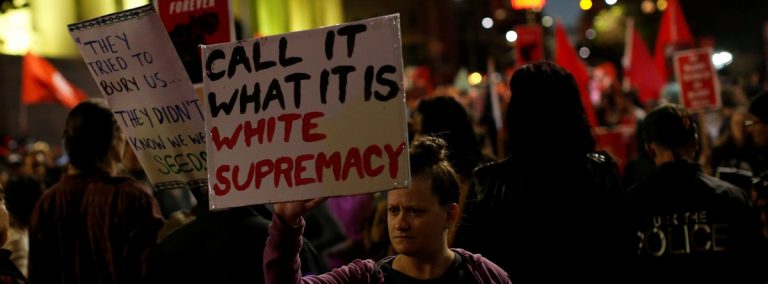
Over the weekend, white supremacists joined a rally “Unite the Right” in Charlottesville, Virginia to protest the removal of a statue of a leader in the pro-slavery Confederate army, known as an affront to African-Americans.
The rally turned into a national tragedy for the sleepy university town when a 20-year-old Adolf Hitler fan smashed his car into the crowd, killing a 32-year-old woman and injuring 19 others, Reuters reported.
As the country reels from shock, educators took to sharing their ideas on how to confront racism and bigotry online, according to NPR, which compiled them into a list.
“There’s a whole lot teachers can slow down and unpack with their students rather than get completely caught up in the emotion of the moment,” says Roger Brooks, president and CEO of nonprofit Facing History and Ourselves, which creates educational material on prejudices and injustice in American and European society, focusing on Nazi Germany and the Holocaust.

Members of white nationalists clash against a group of counter-protesters. Source: Reuters/Joshua Roberts.
For younger students, teachers can talk about race or racism using the help of an “identity chart”, a graphic tool to help them understand themselves, groups, nations as well as historical and literary figures.
Using these “identity cards”, students can “build relationships” and “break down stereotypes”, according to Facing History’s website.
To learn about segregationism and the urban renewal that displaced African-Americans in the city, there’s a syllabus on Medium that lists primary and secondary historical resources on the issue.
Produced by the Graduate Student Coalition for Liberation at the University of Virginia in Charlottesville, the syllabus also provides background on the statue that was the focal point of the rally last weekend.
The hashtag #CharlottesvilleCurriculum, on the other hand, is aimed at being an ongoing list of resources for teachers, parents and anyone else to tap into, in response to current events.
In an email to Washington Post, Melinda Anderson, a contributing writer for The Atlantic, said she started the hashtag as a way “to crowdsource resources” to help explore the history behind white supremacy and “bring context and clarity to Saturday’s events in Virginia”.
We will begin class today by analyzing #Charlottesville photos. Email jarred.amato@gmail for the docs. #CharlottesvilleCurriculum pic.twitter.com/OTniZ7HI2T
— Jarred Amato (@jarredamato) August 14, 2017
In one example, high school English teacher, Jarred Amato tweeted a photo of his class plan to analyse photos from the Charlottesville event, where students have to answer questions like “Who is in the image?” and “What are the people doing?”
Liked this? Then you’ll love these…
Rallying cry: Youth must stand up to defend democracy
US: University wants to hire officer to teach students not to be racists







